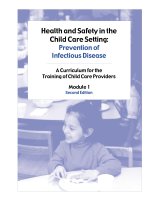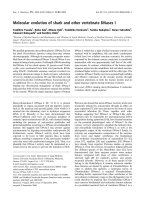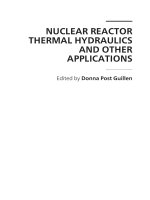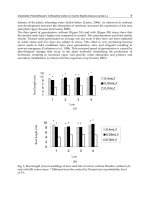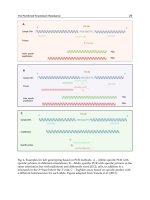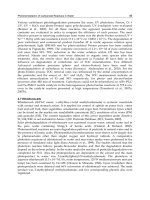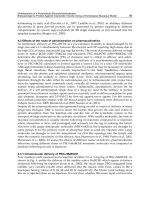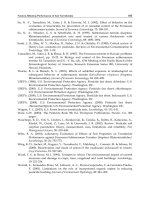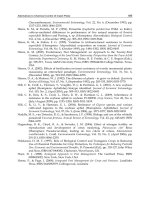MOLECULAR DIAGNOSTICS: GENITOURINARY INFECTIOUS DISEASE TESTING AND OTHER APPLICATIONS FOR AMPLIFIED PROBE TESTING
Bạn đang xem bản rút gọn của tài liệu. Xem và tải ngay bản đầy đủ của tài liệu tại đây (340.44 KB, 12 trang )
<span class="text_page_counter">Trang 1</span><div class="page_container" data-page="1">
<b>LCD L32567 - Molecular Diagnostics: Genitourinary Infectious Disease Testing and Other Applications for Amplified Probe </b>
Molecular Diagnostics: Genitourinary Infectious Disease Testing and Other Applications for Amplified Probe Testing
<b><small>Contractor’s Determination Number </small></b>
L32567
<b><small>AMA CPT/ADA CDT Copyright Statement </small></b>
CPT only copyright 2002-2011 American Medical Association. All Rights Reserved. CPT is a registered trademark of the American Medical Association. Applicable FARS/DFARS Apply to Government Use. Fee schedules, relative value units, conversion factors and/or related components are not assigned by the AMA, are not part of CPT, and the AMA is not recommending their use. The AMA does not directly or indirectly practice medicine or dispense medical services. The AMA assumes no liability for data contained or not contained herein. The Code on Dental Procedures and
Nomenclature (Code) is published in Current Dental Terminology (CDT). Copyright © American Dental Association. All rights
reserved. CDT and CDT-2010 are trademarks of the American Dental Association.
<b><small>Primary Geographic Jurisdiction </small></b>
Pennsylvania, Maryland, District of Columbia, New Jersey, Delaware
<b><small>Oversight Region </small></b>
Central Office
<b><small>Original Determination Effective Date </small></b>
For services performed on or after 11/15/2012
<b><small>Original Determination Ending Date </small></b>
N/A
<b><small>Revision Effective Date </small></b>
For services performed on or after N/A
<b><small>Revision Ending Date </small></b>
N/A
<b><small>CMS National Coverage Policy </small></b>
</div><span class="text_page_counter">Trang 2</span><div class="page_container" data-page="2">Title XVIII of the Social Security Act, Section 1862(a)(1)(A) states that no Medicare payment shall be made for items or services which are not reasonable and
necessary for the diagnosis or treatment of illness or injury.
Title XVIII of the Social Security Act, Section 1862(a)(7). This section excludes routine physical examinations.
Title XVIII of the Social Security Act, Section 1833(e) states that no payment shall be made to any provider for any claim that lacks the necessary information to process the claim.
Title XVIII of the Social Security Act, Section 1862(a)(1)(D) states that no Medicare payment may be made for any expenses incurred for items or services that are investigational or experimental.
42 Code of Federal Regulations (CFR) section 410.32 indicates diagnostic tests are payable only when ordered by the physician who is treating the beneficiary for a specific medical problem and who uses the results in such treatment.
CMS Internet-Only Manual (IOM), Publication 100-02, Medicare Benefit Policy
<i>Manual, Chapter 15, Section 80.1, 80.1.1, 80.1.2, 80.1.3, laboratory services must </i>
meet applicable requirements of CLIA.
<i>CMS IOM, Publication 100-08, Medicare Program Integrity Manual, Chapter 3, </i>
Section 3.4.1.3, Diagnosis Code Requirement.
<i>CMS IOM, Publication 100-08, Medicare Program Integrity Manual, Chapter 3, </i>
Section 3.6.2.3, Limitation of Liability Determinations.
<b><small>Indications and Limitations of Coverage and/or Medical Necessity </small></b>
<i>Compliance with the provisions in this policy may be monitored and addressed through post payment data analysis and subsequent medical review audits. </i>
Molecular diagnostic testing, which includes DNA- or RNA-based analysis, with or without amplification/quantification, provides sensitive, specific and timely (i.e., relative to that of traditional culture-based methods) identification of diverse
biological entities, including microorganisms and tumors. The current LCD will focus upon such techniques for the former category, in which three basic nucleic acid assay platforms are utilized.
<b>Assay Format #1: A standardized nucleic acid probe reacts directly with nucleic </b>
acids in the test sample. This format is termed a Nucleic Acid Test (NAT). If the test sample contains the organism of interest, then the reaction (e.g., hybridization) of these elements will create a detectable endpoint.
<b>Assay Format #2: Test sample nucleic acid is detected following amplification. </b>
This format is termed a Nucleic Acid Amplification Test (NAAT). The NAAT format increases diagnostic sensitivity by decreasing the lower limit of detection. Several techniques are available to perform such amplification, but one example is the polymerase chain reaction in which logarithmic copies of baseline nucleic acid material can be replicated via cyclical reactions involving "primer" nucleic acid,
</div><span class="text_page_counter">Trang 3</span><div class="page_container" data-page="3">enzymes and requisite heating/cooling parameters.
<b>Assay Format #3: Finally, there may be a need for the above process to quantify, </b>
rather than simply detect the presence of, certain microorganisms. Examples include Human Immunodeficiency Virus (HIV), hepatitis C and Cytomegalovirus (CMV) treatment, which can require such quantitative monitoring to determine if therapy is producing the intended reductions in circulating levels of virus.
Furthermore, other techniques (i.e., nucleic acid sequencing) are utilized to assay anti-viral resistance signatures for HIV-1 and hepatitis C. Either genotypic or phenotypic analysis can allow therapy to be directed in response to such observed resistance markers.
There are many different organisms whose clinical presentations can be grouped into several categories or clusters. The limited coverage table below denotes infectious disease manifestations in the area of genitourinary (“GU”) testing for those organisms where specific CPT codes exist versus organisms which would
<b>require non-specific coding. However, this current LCD will focus upon more atypical, less frequent pathogens, whose application in the area of GU, using Assay Format #2 above (that is, the amplified probe technique), has NOT been well-established. </b>
These organisms, which generally pertain to the non-GU setting are are as follows: Ehrlichia species, Herpes virus-7, West Nile virus,Leishmania species, Parvovirus B19, Babesia species, Bordetella pertussis, parainfluenza virus 1/2/3, SARS-related coronavirus, H1N1 virus,Toxoplasma gondii, Epstein-Barr
virus, Varicella-zoster virus, Polyomavirus [JC/BK], and HTLV-1. Furthermore, the practice of large multiplex panels do not serve beneficiaries nearly as well as targeting amplification methods for no more than two organisms at a time, which reflect the most pertinent clinical presentations of such beneficiaries. Finally, amplification testing for Candida infections should be reserved for either serious, recurrent infections or those infections which have been refractory to therapy.
<small>Go to Top</small>
<b>Coding Information <small>Bill Type Codes </small></b>
Contractors may specify Bill Types to help providers identify those Bill Types
typically used to report this service. Absence of a Bill Type does not guarantee that the policy does not apply to that Bill Type. Complete absence of all Bill Types
indicates that coverage is not influenced by Bill Type and the policy should be assumed to apply equally to all claims.
012x Hospital Inpatient (Medicare Part B only) 013x Hospital Outpatient
014x Hospital - Laboratory Services Provided to Non-patients
</div><span class="text_page_counter">Trang 4</span><div class="page_container" data-page="4">018x Hospital - Swing Beds
021x Skilled Nursing - Inpatient (Including Medicare Part A) 022x Skilled Nursing - Inpatient (Medicare Part B only) 023x Skilled Nursing - Outpatient
071x Clinic - Rural Health
072x Clinic - Hospital Based or Independent Renal Dialysis Center 073x Clinic - Freestanding
075x Clinic - Comprehensive Outpatient Rehabilitation Facility (CORF) 077x Clinic - Federally Qualified Health Center (FQHC)
083x Ambulatory Surgery Center 085x Critical Access Hospital
<b><small>Revenue Codes </small></b>
Contractors may specify Revenue Codes to help providers identify those Revenue Codes typically used to report this service. In most instances Revenue Codes are purely advisory; unless specified in the policy services reported under other Revenue Codes are equally subject to this coverage determination. Complete absence of all Revenue Codes indicates that coverage is not influenced by Revenue Code and the policy should be assumed to apply equally to all Revenue Codes.
030X Laboratory - General Classification
031X Laboratory Pathology - General Classification
<b><small>CPT/HCPCS Codes </small></b>
Italicized and/or quoted material is excerpted from the American Medical
<i>Association, Current Procedural Terminology (CPT) codes. </i>
87480 <sup>INFECTIOUS AGENT DETECTION BY NUCLEIC ACID (DNA OR </sup> RNA); CANDIDA SPECIES, DIRECT PROBE TECHNIQUE
87490
INFECTIOUS AGENT DETECTION BY NUCLEIC ACID (DNA OR RNA); CHLAMYDIA TRACHOMATIS, DIRECT PROBE
TECHNIQUE
87491 <sup>INFECTIOUS AGENT DETECTION BY NUCLEIC ACID (DNA OR </sup>RNA); CHLAMYDIA TRACHOMATIS, AMPLIFIED PROBE
</div><span class="text_page_counter">Trang 5</span><div class="page_container" data-page="5">TECHNIQUE
87510 <sup>INFECTIOUS AGENT DETECTION BY NUCLEIC ACID (DNA OR </sup> RNA); GARDNERELLA VAGINALIS, DIRECT PROBE TECHNIQUE 87590 <sup>INFECTIOUS AGENT DETECTION BY NUCLEIC ACID (DNA OR </sup>
RNA); NEISSERIA GONORRHOEAE, DIRECT PROBE TECHNIQUE
87591
INFECTIOUS AGENT DETECTION BY NUCLEIC ACID (DNA OR RNA); NEISSERIA GONORRHOEAE, AMPLIFIED PROBE
TECHNIQUE
87660 <sup>INFECTIOUS AGENT DETECTION BY NUCLEIC ACID (DNA OR </sup> RNA); TRICHOMONAS VAGINALIS, DIRECT PROBE TECHNIQUE
87798
INFECTIOUS AGENT DETECTION BY NUCLEIC ACID (DNA OR RNA), NOT OTHERWISE SPECIFIED; AMPLIFIED PROBE
TECHNIQUE, EACH ORGANISM
<b><small>ICD-9 Codes that Support Medical Necessity </small></b>
It is the provider’s responsibility to select codes carried out to the highest level of specificity and selected from the ICD-9-CM code book appropriate to the year in which the service is rendered for the claim(s) submitted.
Medicare is establishing the following limited coverage for Chlamydia trachomatis
<i>(87490,87491), Neisseria gonorrhoeae (87590,87591), Candida species (87480), Gardnerella vaginalis (87510) and Trichomonas vaginalis (87660): </i>
076.0 - 076.1 TRACHOMA INITIAL STAGE - TRACHOMA ACTIVE STAGE 076.9 TRACHOMA UNSPECIFIED
077.0 INCLUSION CONJUNCTIVITIS
077.98 - 077.99
UNSPECIFIED DISEASES OF CONJUNCTIVA DUE TO
CHLAMYDIAE - UNSPECIFIED DISEASES OF CONJUNCTIVA DUE TO VIRUSES
098.0 <sup>GONOCOCCAL INFECTION (ACUTE) OF LOWER </sup> GENITOURINARY TRACT
098.10 - 098.17
GONOCOCCAL INFECTION (ACUTE) OF UPPER
GENITOURINARY TRACT SITE UNSPECIFIED - GONOCOCCAL SALPINGITIS SPECIFIED AS ACUTE
098.19 <sup>OTHER GONOCOCCAL INFECTION (ACUTE) OF UPPER </sup> GENITOURINARY TRACT
098.2 <sub>GONOCOCCAL INFECTION CHRONIC OF LOWER </sub>
</div><span class="text_page_counter">Trang 6</span><div class="page_container" data-page="6">GENITOURINARY TRACT
098.30 - 098.37
CHRONIC GONOCOCCAL INFECTION OF UPPER
GENITOURINARY TRACT SITE UNSPECIFIED - GONOCOCCAL
098.49 OTHER GONOCOCCAL INFECTION OF EYE
098.50 - 098.53 GONOCOCCAL ARTHRITIS - GONOCOCCAL SPONDYLITIS 098.59 OTHER GONOCOCCAL INFECTION OF JOINT
098.6 - 098.7 <sup>GONOCOCCAL INFECTION OF PHARYNX - GONOCOCCAL </sup> INFECTION OF ANUS AND RECTUM
098.81 - 098.86 <sup>GONOCOCCAL KERATOSIS (BLENNORRHAGICA) - </sup>
OTHER VENEREAL DISEASES DUE TO CHLAMYDIA TRACHOMATIS UNSPECIFIED SITE - OTHER VENEREAL
DISEASES DUE TO CHLAMYDIA TRACHOMATIS PERITONEUM 099.59 <sup>OTHER VENEREAL DISEASES DUE TO CHLAMYDIA </sup>
TRACHOMATIS OTHER SPECIFIED SITE
112.1 - 112.2 <sup>CANDIDIASIS OF VULVA AND VAGINA - CANDIDIASIS OF </sup> OTHER UROGENITAL SITES
131.00 - 131.03 <sup>UROGENITAL TRICHOMONIASIS UNSPECIFIED - </sup> TRICHOMONAL PROSTATITIS
131.09 OTHER UROGENITAL TRICHOMONIASIS
131.8 - 131.9 <sup>TRICHOMONIASIS OF OTHER SPECIFIED SITES - </sup> TRICHOMONIASIS UNSPECIFIED
288.00 - 288.04 NEUTROPENIA, UNSPECIFIED - NEUTROPENIA DUE TO
</div><span class="text_page_counter">Trang 7</span><div class="page_container" data-page="7">372.00 ACUTE CONJUNCTIVITIS UNSPECIFIED
372.02 - 372.03 <sup>ACUTE FOLLICULAR CONJUNCTIVITIS - OTHER </sup> MUCOPURULENT CONJUNCTIVITIS
372.10 - 372.12 <sup>CHRONIC CONJUNCTIVITIS UNSPECIFIED - CHRONIC </sup> FOLLICULAR CONJUNCTIVITIS
595.4 CYSTITIS IN DISEASES CLASSIFIED ELSEWHERE
597.80 - 597.81 URETHRITIS UNSPECIFIED - URETHRAL SYNDROME NOS
604.90 - 604.91 <sup>ORCHITIS AND EPIDIDYMITIS UNSPECIFIED - ORCHITIS AND </sup> EPIDIDYMITIS IN DISEASES CLASSIFIED ELSEWHERE
608.89 OTHER SPECIFIED DISORDERS OF MALE GENITAL ORGANS 614.0 ACUTE SALPINGITIS AND OOPHORITIS
614.2 - 614.4
SALPINGITIS AND OOPHORITIS NOT SPECIFIED AS ACUTE SUBACUTE OR CHRONIC - CHRONIC OR UNSPECIFIED PARAMETRITIS AND PELVIC CELLULITIS
614.6 <sup>PELVIC PERITONEAL ADHESIONS FEMALE (POSTOPERATIVE) </sup> (POSTINFECTION)
614.8 - 614.9
OTHER SPECIFIED INFLAMMATORY DISEASE OF FEMALE PELVIC ORGANS AND TISSUES - UNSPECIFIED
INFLAMMATORY DISEASE OF FEMALE PELVIC ORGANS AND TISSUES
</div><span class="text_page_counter">Trang 8</span><div class="page_container" data-page="8">616.0 CERVICITIS AND ENDOCERVICITIS
616.81 MUCOSITIS (ULCERATIVE) OF CERVIX, VAGINA, AND VULVA 616.89 <sup>OTHER INFLAMMATORY DISEASE OF CERVIX, VAGINA AND </sup>
VULVA
616.9 <sup>UNSPECIFIED INFLAMMATORY DISEASE OF CERVIX VAGINA </sup> AND VULVA
628.2 INFERTILITY FEMALE OF TUBAL ORIGIN
629.89 OTHER SPECIFIED DISORDERS OF FEMALE GENITAL ORGANS
711.90 - 711.99
UNSPECIFIED INFECTIVE ARTHRITIS SITE UNSPECIFIED - UNSPECIFIED INFECTIVE ARTHRITIS INVOLVING MULTIPLE SITES
716.50 - 716.59
UNSPECIFIED POLYARTHROPATHY OR POLYARTHRITIS SITE UNSPECIFIED - UNSPECIFIED POLYARTHROPATHY OR
POLYARTHRITIS INVOLVING MULTIPLE SITES
716.60 - 716.68
UNSPECIFIED MONOARTHRITIS SITE UNSPECIFIED -
UNSPECIFIED MONOARTHRITIS INVOLVING OTHER SPECIFIED SITES
716.90 - 716.99 <sup>UNSPECIFIED ARTHROPATHY SITE UNSPECIFIED - </sup>
UNSPECIFIED ARTHROPATHY INVOLVING MULTIPLE SITES 719.40 - 719.49 <sup>PAIN IN JOINT SITE UNSPECIFIED - PAIN IN JOINT INVOLVING </sup>
MULTIPLE SITES
727.00 SYNOVITIS AND TENOSYNOVITIS UNSPECIFIED 727.05 - 727.06 <sup>OTHER TENOSYNOVITIS OF HAND AND WRIST - </sup>
TENOSYNOVITIS OF FOOT AND ANKLE 727.09 OTHER SYNOVITIS AND TENOSYNOVITIS
771.6 NEONATAL CONJUNCTIVITIS AND DACRYOCYSTITIS 780.60 - 780.61 <sup>FEVER, UNSPECIFIED - FEVER PRESENTING WITH </sup>
CONDITIONS CLASSIFIED ELSEWHERE
782.1 RASH AND OTHER NONSPECIFIC SKIN ERUPTION 785.6 ENLARGEMENT OF LYMPH NODES
</div><span class="text_page_counter">Trang 9</span><div class="page_container" data-page="9">788.64 - 788.65 URINARY HESITANCY - STRAINING ON URINATION
ABDOMINAL OR PELVIC SWELLING MASS OR LUMP
UNSPECIFIED SITE - ABDOMINAL OR PELVIC SWELLING MASS
789.69 ABDOMINAL TENDERNESS OTHER SPECIFIED SITE 789.9 OTHER SYMPTOMS INVOLVING ABDOMEN AND PELVIS
790.4 - 790.5
NONSPECIFIC ELEVATION OF LEVELS OF TRANSAMINASE OR LACTIC ACID DEHYDROGENASE (LDH) - OTHER NONSPECIFIC ABNORMAL SERUM ENZYME LEVELS
791.0 - 791.7 PROTEINURIA - OTHER CELLS AND CASTS IN URINE
791.9 OTHER NONSPECIFIC FINDINGS ON EXAMINATION OF URINE
<b>Medicare is establishing the following limited coverage for </b>
<i><b>human papillomavirus (87621): </b></i>
622.10 - 622.12 <sup>DYSPLASIA OF CERVIX, UNSPECIFIED - MODERATE </sup> DYSPLASIA OF CERVIX
795.00 - 795.01 ABNORMAL GLANDULAR PAPANICOLAOU SMEAR OF CERVIX - PAPANICOLAOU SMEAR OF CERVIX WITH ATYPICAL
</div><span class="text_page_counter">Trang 10</span><div class="page_container" data-page="10">SQUAMOUS CELLS OF UNDETERMINED SIGNIFICANCE (ASC-US)
795.03 <sup>PAPANICOLAOU SMEAR OF CERVIX WITH LOW GRADE </sup> SQUAMOUS INTRAEPITHELIAL LESION (LGSIL)
<i><b>Medicare is establishing the following limited coverage for 87798 (Detect </b></i>
<b>agent nos dna amp): </b>
<b>NOTE: Both H1N1 and Polyomavirus [JC/BK] viruses are still pending the most precise ICD-9 coding, and for any such organisms not amenable to final specific ICD-9 coding, please report the presumed organism in block 19 (or the electronic claim). </b>
033.0 <sup>WHOOPING COUGH DUE TO BORDETELLA PERTUSSIS (B. </sup> PERTUSSIS)
053.0 - 053.9 <sup>HERPES ZOSTER WITH MENINGITIS - HERPES ZOSTER </sup> WITHOUT COMPLICATION
058.82 HUMAN HERPESVIRUS 7 INFECTION 066.40 WEST NILE FEVER, UNSPECIFIED 075 INFECTIOUS MONONUCLEOSIS
079.51 HUMAN T-CELL LYMPHOTROPHIC VIRUS TYPE I [HTLV-I] 079.83 PARVOVIRUSB19
079.89 OTHER SPECIFIED VIRAL INFECTION
082.40 - 082.49 UNSPECIFIED EHRLICHIOSIS - OTHER EHRLICHIOSIS 085.1 - 085.9 <sup>CUTANEOUS LEISHMANIASIS URBAN - LEISHMANIASIS </sup>
UNSPECIFIED 088.82 BABESIOSIS
130.9 TOXOPLASMOSIS UNSPECIFIED
<b><small>Diagnoses that Support Medical Necessity </small></b>
Conditions that are listed in the "ICD-9 Codes that Support Medical Necessity" section of this policy.
<b><small>ICD-9 Codes that DO NOT Support Medical Necessity </small></b>
All those not listed under the "ICD-9 Codes that Support Medical Necessity" section of this policy.
<b><small>ICD-9 Codes that DO NOT Support Medical Necessity Asterisk Explanation </small></b>
</div>
